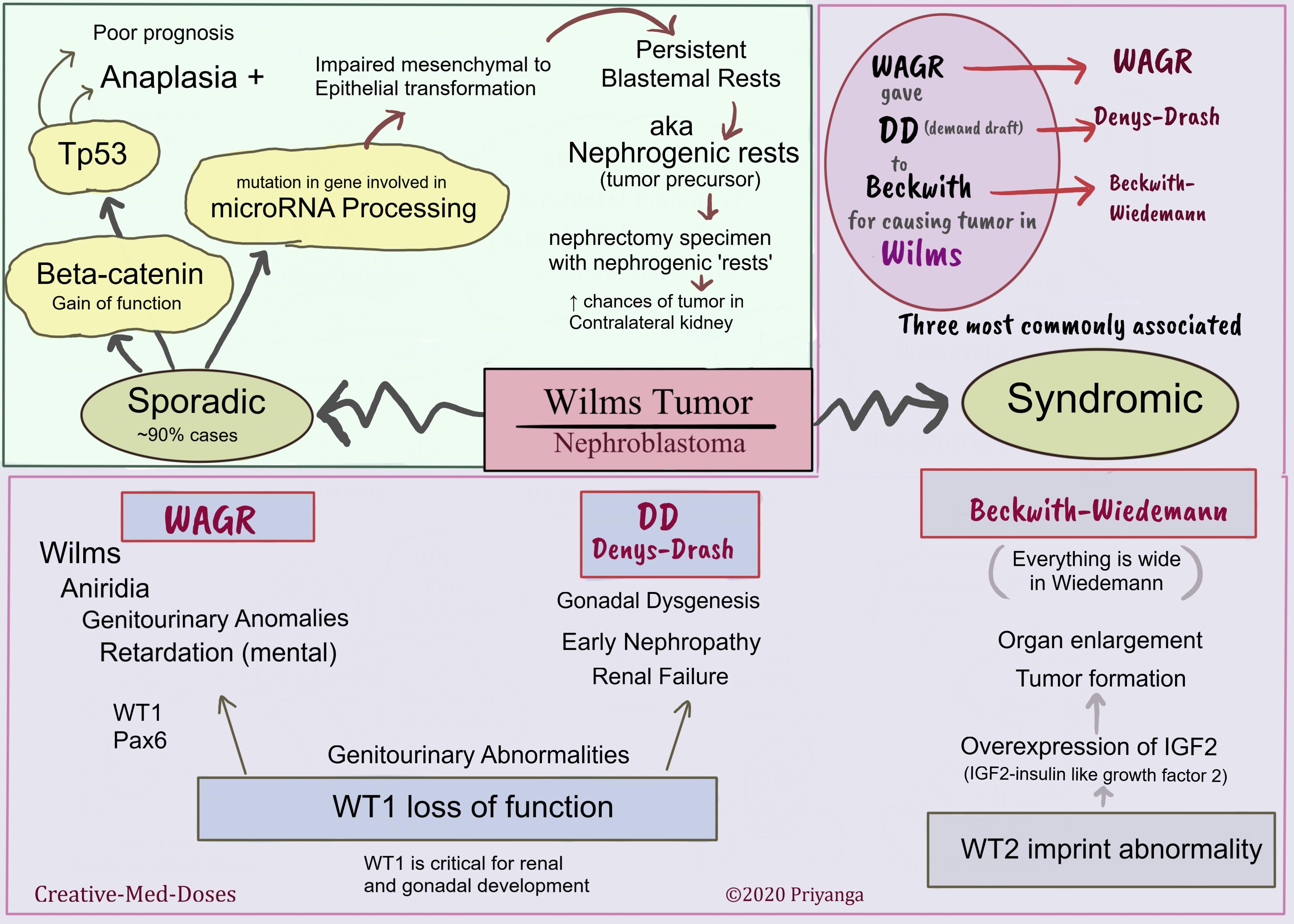Wilms tumor: nephroblastoma
Wilms tumor (nephroblastoma) is the most common primary tumor of the kidney in children. Most cases are children between 2 and 5 years of age.
Pathogenesis
Sporadic (nearly 90%of cases) –
Molecular abnormalities related to sporadic cases are-
- the beta-catenin gain of function mutation
- Tp53 mutation
- microRNA processing defect
Syndromic –
It is associated with other genetic mutations and hereditary conditions.
The following three are most commonly associated with Wilms tumor-
WAGR Syndrome-
Wilms tumor, Aniridia, Genitourinary abnormalities, and mental Retardation are present in this syndrome. It is associated with the deletion of the WT1 gene and Pax6 gene. The WT1 gene is critical for renal and gonadal development. The loss of WT1 causes renal tumors and genitourinary abnormalities.
DD (Denys-Drash) Syndrome
It is characterized by gonadal dysgenesis and Early-onset nephrotic syndrome caused by diffuse mesangial sclerosis. The patients can get renal failure at a very early age. It is also associated with WT1 mutation.
Beckwith-wiedemann syndrome
These patients have enlargement of body organs (for example -tongue, kidneys, or liver) or entire body segments (hemihypertrophy). The enlargement of adrenal cortical cells (adrenal cytomegaly) is a characteristic microscopic feature.
It is a disorder of genomic imprinting of the WT2 gene which is associated with IGF-2 (insulin-like growth factor-2). Imprinting abnormalities lead to overexpression of the IGF2 and cause organomegaly, cytomegaly, and tumor formation.
These patients have an increased risk of developing various tumors, for example –
- Wilms tumor
- Hepatoblastoma
- Adrenocortical tumors
- Pancreatic tumors
...

...
Morphology
The cut section shows tan grey areas along with areas of hemorrhage, cyst formation, and necrosis. Wilms tumor consists of embryonic glomerular structures.
Triphasic tumor – the tumor is composed of three verities of cells that’s why it is a triphasic tumor.
- Blastemal cells
- Stromal cells
- Epithelial cells (immature glomeruli and tubules)
Some cases show anaplastic appearance which is associated with poor prognosis.
Clinical presentation
Abdominal mass
- Painless Palpable mass
- Nontender and homogenous
- Incidental finding of abdominal mass by a physician during a routine examination of an otherwise healthy child or by mother during bath and changing clothes of the child is the most common presentation.
Hematuria- when the tumor is ruptured or has invaded the collecting system.
Hypertension- due to renin secretion.
Intestinal obstruction- due to external compression of the intestine by growing tumor.
Fever and anemia
Diagnosis
- Abdominal ultrasound is the best initial test.
- Abdominal CT or MRI is done to identify the extent of tumor involvement and metastasis.
- Histopathological examination of resected tumor specimen (nephrectomy specimen) helps in tumor staging, metastasis extent, and determining the prognosis. Biopsy of the tumor is not indicated due to the risk of the tumor capsule rupture and spillage while doing the procedure.
Prognosis
Most cases have a good prognosis. The anaplastic appearance and Tp53 mutation are associated with the worst prognosis. The presence of nephrogenic rests in the resected specimen of the tumor is associated with increased chances of tumor formation in the contralateral kidney.
Treatment
- Nephrectomy and chemotherapy
- Radiation is added in advanced tumors with bilateral renal involvement and metastasis.
A 3-year-old boy is brought to the emergency room after his mother discovers a mass in the boy’s abdomen while changing clothes. The boy is otherwise asymptomatic and does not have any abdominal pain. On exam, he is found to be hypertensive. Physical examination shows a palpable, non-tender mass on the right side, which does not cross the midline. The radiological evaluation suggests a large 25 cm × 22 cm tumor arising from the right kidney with no intravascular extension. Which of the following is most likely associated with his illness –
- Nephrogenic rests
- Retinal angiomatosis
- Salt wasting nephropathy
- Trisomy 7
Answer is A. nephrogenic rests
Revision for today Shock: Systemic hypoperfusion - Creative Med Doses
Buy fun review books here (these are kindle eBooks you can download kindle on any digital device and log in with Amazon accounts to read them). Have fun and please leave a review.
https://creativemeddoses.com/books/